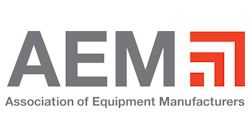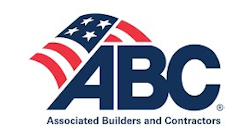Traditionally, surveying in the construction industry has been a skilled, labor-intensive process involving transits, levels, theodolites, and other manual devices. Peter Wallace of Topcon America in Lonoke, AR, notes, “The construction industry is like a manufacturing industry, but it is far less automated than any of the large manufacturing industries. And this has been particularly true in its approach to the precise science of surveying.”
That situation, however, is slowly but surely changing. For example, Worldwide Land Surveyors of Martinez, CA, has been steadily automating its 25 field surveying crews. Founded in 1976 by Gary Freitas, this surveying and civil engineering company now has two Global Positioning Systems (GPS) and nine robotic surveying instruments augmenting its 15 essentially manual total stations. What’s more, the firm hopes to change this mix to half GPS, half robotic total stations, and no manual total stations. According to part-owner Gene Feickert, “Robotic instruments have increased our crew productivity by at least 30%, and GPS is so much better than manual techniques for the control application that there’s simply no comparison.”
This is a professional surveyor talking, of course, and one might think that construction contractors would have only a passing interest in a surveying company’s decision to automate. In today’s world, though, contractors are intimately involved in the surveying process. Feickert estimates that more than 90% of his firm’s contracts are directly with contractors who include the cost of the surveying in their bids and their contract prices. Moreover, as the modern surveying systems have become more productive, less expensive, and easier to use, contractors are beginning to buy them themselves and train captive crews in their operation.
Wallace is emphatic on the subject. “Over the past few years, one of the major changes regarding surveying in the construction industry has been that a lot of midsize to large contractors are hiring surveyors to work within their companies. This gives them more control over all aspects of the job site.”
Paul Hahn of Spectra Precision in Dayton, OH, elaborates on this shift. “It’s been the booming economy,” he asserts. “With all the construction going on, land surveyors can’t respond to contractor requests as quickly as contractors need if they are meeting pressing construction schedules. By buying a robotic total station, for example, a contractor not only saves money, he conserves time as well. Even more important, he is assured that the survey will be done when it is needed to keep his machines moving.
“Since surveying instruments and systems are so much easier to use today, he doesn’t even have to hire experienced surveying crews that are so hard to find these days. Since less technique is needed than it would be with transits and levels, a contractor can take one of his bright people and have him trained to operate one of the more automated instruments or systems.”
Since contractors are likely to become much more involved in the use of automated surveying instruments and systems, it is useful to take a look at some of the more popular ones.
Total stations are by far the most widely used surveying systems today. Similar to transits, they provide horizontal and vertical angle, but they also measure distance. A traditional total station uses a prism reflector that reflects back a signal. From a known location, the fixed station transmits a frequency that, when reflected back, enables the sending unit to count the waves that went out and came back and thereby measure the distance from the reflector. Two crewmembers are required: one at the transmitter and one at the reflector.
It should be noted that Feickert’s determination to replace his firm’s total stations might be largely because they consist of an older, manual model-the Topcon GTS-300. While the GTS-300 was quite useful and very popular in its day, improvements in technology have passed it by. In the Topcon line, it has been replaced by the waterproof GTS-600, which adds such modern productivity-enhancing features as auto-focus, data storage for 5,000 points, and longer range (3,000 m to a single prism or laser).
Virtually all manufacturers in the industry offer total stations in their product lines because they are relatively low-cost yet still quite useful devices. Some units use a rotating laser to generate the signal, points out Ron Russell of Martronic Engineering in Simi Valley, CA. In laying out a pad, the laser sends out a level beam of light to the receiver. Arrows on the receiver show the crewman where he is in relation to the grade they are trying to establish. Once a benchmark is established, the rod with the sensor is moved throughout the pad so that it can be determined whether points are high or low in relation to the benchmark. This information then determines the grading needed.
There are a variety of different types of total stations. Some use GPS positioning, some use prism reflectors, and others use laser beams. Trimble, for example, offers both GPS total stations and Optical-based total stations and a survey controller that Jon Casamajor, business development manager for Trimble’s Construction Systems Group in Sunnyvale, CA says seamlessly links between the company’s Optical Survey Family and its GPS total stations. “Both technologies can and should be in a surveyor’s toolbox.”
Topcon has a number of different total station models designed to meet different construction needs and budgets. In addition to its GTS-600 auto-focus total stations, the company markets its GPS-1003, which utilizes pulse-laser EDM technology for applications in which distance measurement is needed but the placement of a prism reflector is either dangerous or difficult.
In addition, Topcon’s GTS-800 series of total stations can be modularly upgraded to a motorized or robotic total station without a cost penalty. The GTS-800, which lists at about $16,000, can be field-upgraded to the $22,000 motorized GPS-800A model for an additional $6,000, or it can be field-upgraded to the $30,000 robotic GPS-800AR for an additional $14,000. Thus, a customer with budgetary restrictions can buy the GTS-800 knowing he can upgrade it later without paying a cost penalty.
Robotic Surveying Systems
“Robotic surveying systems represent the fastest-growing segment of the entire surveying market,” asserts Spectra Precision’s Hahn. “And the construction market for surveying systems is growing the fastest of all because contractors are buying and using these robotic systems themselves.”
In robotic surveying, a crewmember sets up the instrument in a suitable position and establishes a station in the usual way. Then he removes the control unit from the instrument, attaches it to the rover unit, and goes to the first measuring point. When he presses the search key, the instrument finds and locks onto the reflector. Then he uses the control unit exactly as if it were still on the instrument. The only difference is that he is standing at the measuring point, where he has the opportunity to spot any errors.
Hahn claims there is no quicker, more efficient, or more accurate instrument than the robotic total station. “Think about it: You don’t have to worry about adjusting and focusing. And because nobody is needed at the instrument, both you and your assistant can help with the work at the measuring point.
“You can measure in poor visibility and in total darkness, if necessary. The active search system is superior to the human eye and always finds the reflector. And you could do the job completely alone if you had to. One person can process as many points in the same time as it takes two people measuring with a conventional total station. Is there a better insurance against work stoppages?”
Of course, these robotic systems are more costly than manual total stations-roughly double the purchase price, in fact. And with the up-and-down nature of the construction business, contractors might be hesitant to make this additional investment. Several years ago, Hahn addressed this question. “The decision to take on the debt of expensive, albeit highly productive, systems might seem unwise.”
However, the most costly item in the surveying business is labor. If your new investment in technology results in labor savings, you are well positioned, whether the economy is on the rise or in decline. If the economy is expanding, you need the capacity to accomplish more work with the same number of people. If the economy is contracting, you need to find a competitive edge with fewer people. The following example shows the relationship of field equipment and labor costs.
| Expense | Total Station | Robotic Total Station |
| Instrument Purchase Price | $10,000 | $38,000 |
| Instrument Write-off Time | 5 years | 5 years |
| Instrument Cost per Year | $2,000 | $7,600 |
| Instrument Cost per Day | $9.09 | $34.54 |
| Labor Costs per Day* | $216 |
$168 |
| Total Costs per Day | $225.09 | $202.54 |
| Total Cost Savings per Day | – | $22.55 |
| Total Cost Savings per Year | – | $5,638 |
| Total Cost Savings over 5 Years | – | $28,190 |
* Calculations assume daily field labor costs of $15/hour and $12/hour (with benefits) and that at least 50% of the year the higher-paid employee will work alone. It also assumes only 250 working days per year. For stakeout work, one less person would be used, reducing crew size from three to two, resulting in a similar savings. Although increases in productivity are well documented, these increases are not taken into consideration. Doing so would favorably impact a more thorough return-on-investment analysis.
Those labor costs may seem quaintly conservative, but it must be remembered that Hahn made this analysis three years ago. Today a labor cost of $20/hour would be more realistic, and if this figure was used, the total five-year savings would be about $40,000.
Worldwide Land Surveyors decided to do its own return on investment (ROI). Feickert says, “Even our most conservative estimates showed that the robotic surveying technology would pay for itself in about two years. We knew that in order to grow, we would have to buy more stations anyway, so why not get systems that would increase our productivity and reduce our labor? We might only have to pay half as much for a traditional total station, but we wouldn’t get the return.”
Accordingly, Worldwide bought six Spectra Precision robotic stations and put them to work. After an introductory period, the firm found that the productivity increase was even greater than it had hoped for when it prepared its ROI. Recalls Party Chief Sean Finn, “We set a personal record of 450 points in eight hours with two surveyors at the rod with stakes already made up. This was almost twice as many points as we could do in the same amount of time before we had the robotic systems.
“We’ve found that if a project will have 100 stakes or less in a day, one person can get done close to what two would do using traditional equipment. On projects with more than 100 stakes a day, we usually send two crewmembers. If a surveyor is sick, we can split up a two-surveyor crew and put them on two jobs. That way, both jobs still get done and we don’t lose a day. This gives us a lot more options with a given number of surveyors when handling projects.”
“Robotic technology has exceeded all of my expectations,” remarks Feickert. “It’s definitely done all it promised to do.” And his actions back up his words: He has already bought three more systems and plans to buy more as he expands.It is not just surveyors who are sold on robotic systems. Schneider Excavating, a commercial excavating and grading company located in Lannon, WI, near Milwaukee, also upgraded its surveying equipment with a robotic total station, this one manufactured by Topcon.
“We use the system 10 hours a day in the field for grade control and staking,” relates Vice President Gene Leonhardt. “The unit gives a lot of flexibility. Although designed as a one-person total station, we usually use the instrument with two guys: one guy running the gun from the rod and another guy pounding the stakes. On large jobs, this gives us the highest degree of accuracy and the fastest production time possible.
“On one job, we took over 1,500 shots in a few hours. It would take a survey house a couple of days to collect that much data. With our old method, we could complete one or two jobs in a day. Now our guys can do four or five jobs a day. With the system, we have been able to move the dirt more efficiently. Anytime you move the dirt more efficiently, you increase your profits.”
Schneider Excavating purchased another unit just a year later.
Many surveyors use laser rangefinders rather than prisms, particularly in areas where they cannot conveniently reach points to be surveyed or when greater speed is desired. There are a variety of different lasers and laser rangefinders on the market that address different applications of construction surveying.
For example, Laser Technology Inc. (LTI) in Englewood, CO, makes a laser rangefinder that uses an infrared semiconductor laser diode to generate a beam that reflects off any type of surface and that receives a return energy that can be used to calculate the distance to that point. Thus, it does not require a second crewmember to hold a reflector at the point in order to get a measurement.
“Our products calculate distance by measuring the time of flight of very short pulses of infrared light,” explains Steve Colburn, Internet marketing manager for LTI. “This method is different from the traditional surveying-instrument method of measuring phase shifts by comparing the incoming wave length with the phase of the reflected light. Any solid object will reflect back a certain percentage of the emitted light energy; it can be very small and our sensitive detector can still pick it up. We measure the time it takes for a laser pulse to travel to the target and back using a precision, crystal-controlled time base. Knowing the speed of light, the system can then calculate the distance traveled. To increase accuracy, the LTI laser measures as many as 60 pulses, using a least-squares method of determining the range.”
currently, though, the LTI rangefinder has an accuracy limitation of about 1 decimeter, so it is not sufficiently accurate for staking or machine control applications. Its low price ($2,000-$5,000) and light weight (2 lb.), however, make it ideal for initial reconnaissance of prospective sites.
A single operator can visit a prospective site and, staying in one place, survey all the topographic information needed for preliminary evaluation of that site. The surveyor simply aims the handheld rangefinder at a target and presses a button. In this manner, the rangefinder acquires the location and height of targets 100-500 m away in less than a second. With the unit’s point-and-shoot operation and serial output communications capability, the topography of a complete site can be obtained inexpensively and with adequate accuracy for subsequent site analysis.
Most other laser rangefinders have the centimeter-level accuracy needed for staking or machine control applications. Working from a corner point with a known position, a two-person survey crew equipped with such a laser rangefinder can quickly survey and stake even an irregular plot. Standing at that corner point, a crewmember shoots the laser to reflectors held at the other corners and can create an accurate baseline shape used for staking.
Worldwide Land Surveyors, however, doesn’t have any lasers in its toolkit, Feickert says. “They’re fine for flat-pad layout surveying, but for anything more complicated, either a robotic total station or a GPS is far superior. It just doesn’t make sense to us to buy equipment just for flat-pad layout when our robotic total stations and GPS can do that task as well as the more complicated work.”
That same line of logic might well apply to Agatec Construction Lasers’ very simple and inexpensive machine control system that consists of a laser transmitter and a laser receiver. The AM200 transmitter uses an automatic self-leveling dual-grade laser that can set grade from 0° to 9.8° on the x and y horizontal axes. The MR360 laser receiver detects the beam from the laser transmitter up to 200 m from any angle.
According to Pauline Beck of the Menomonee Falls, WI, company, “The components are very basic and straightforward without a lot of menu options or complicated features that can be time-consuming to learn. The receiver has simple arrow commands telling the operator which way to move the blade or bucket to reach the reference plane. This simplicity of use allows all operators on a construction crew to use the system.”
Since an Agatec machine control system with the automatic dual-grade transmitter would cost a contractor just over $4,000, it is an attractive option for small contractors, points out Agatec President Gabriel Tawil. “A small contractor using an excavator is likely to do a variety of work that can use the capabilities of this system. In addition to excavating and grading, the AM200 can be used for other horizontal and vertical tasks, squaring, and even connecting short sewer pipelines from a house to a main.
“Using this system for all these surveying needs, a small contractor doesn’t need a $25,000-a-year grade checker to take rod readings or to set out grade stakes. Thus, it’ll only take a couple of months to see a 100% return on that $4,000 investment.”
The GPS industry was developed courtesy of the United States government. GPS was initially launched by the Department of Defense to provide satellite-generated position information to strategic and tactical armed forces. Then in 1996, a Presidential Directive was issued that ordered the US government to provide the GPS signals free to civilian users. Jon Casamajor of Trimble provides the following description of GPS operation:
“GPS provides precise latitude, longitude, and altitude using a worldwide system of satellites that can provide 24-hour coverage. As a broadcast-only radio system, GPS can have an unlimited number of users. Distance is calculated from the time it takes for the radio signals from the satellites to reach the antenna of the GPS receiver. GPS frequencies penetrate clouds, rain, and snow. It can accurately guide operations in fog or even at night. With today’s receivers, a GPS can provide measurements that are accurate to better than one-tenth of a foot.
“The 24-hour availability of GPS signals provides an infrastructure that is transforming the way people work and live. GPS is widely used in a variety of applications, such as land and marine surveying; mapping and asset management; land, sea, and air navigation; dispatch of public-safety vehicles; fleet vehicle management; and agricultural, mining, and construction-equipment guidance. In a very real sense, it has become an essential public utility.”
While much has been written recently about the application of GPS to machine control systems, the technology has also demonstrated significant advantages for surveying. Tom Mayhew, GPS survey applications engineer for Allen Osborne Associates of Westlake Village, CA, says quite a few surveying customers are upgrading to his firm’s GPS, the Rascal. “The Rascal is a turnkey solution that provides the surveyor with everything needed to conduct all methods of GPS surveying. This translates into dramatic productivity gains. Establishing local control, boundary work, stakeout, and topographic mapping can be accomplished efficiently with a one-person operation.
“If a surveyor is simply tagging points, the Rascal can store 10,000 points in standard memory, and 700 points can be loaded for staking. In addition to its high-accuracy GPS engine, the Rascal provides an alphanumeric keypad and display that eliminate the need for an additional data collector. The unit will also interface with different GPS collectors in use, so customers can continue to use their existing, specialized software.
“We have developed GPS postprocessing software that runs on a computer back at a surveyor’s office. If a surveyor doesn’t want to come in to the office each day, he can interface his Rascal with an RS-232 serial cable to his laptop, and then e-mail the data back to the office for postprocessing. That’s important because some of those long kinematic runs can require files as large as 16 megabytes to be postprocessed. Of course, if the surveyor doesn’t require any postprocessing, the Rascal has a button that lets him just store points and ephemeris data. A GPS can be applied to almost any surveying task.”
Gene Feickert would agree, although until just recently, he believed that the main value of GPS to a surveyor was to establish control points-horizontal and vertical location anchored to a site blueprint. “A GPS is by far the best way to do this,” he remarked and proceeded to buy two Trimble GPS 4800 systems.
Casamajor says, “The GPS total station 4800 packages Trimble’s real-time kinematic GPS survey technology in a lightweight system that has no external cables, batteries, or antennae. The system’s dual-frequency receiver, GPS antenna, data radio, power supply, and cables are integrated into a GPS pole with a total weight of 8.5 pounds. The system doesn’t need a backpack or waistpack, and there are no cables connecting the surveyor to the pole.
“The 4800 is ideal for a broad range of surveys where mobility and ease of movement are important. Surveyors can quickly collect and stake out centimeter-level measurements. Data transfer from the datalogger to the office to the design software and back to the data collector is completely seamless. Moving data between the 4800, other total stations, and conventional instruments is equally simple and transparent.”
With that description, it’s no wonder Feickert bought 4800s, but the new systems soon proved to have greater application than he had anticipated.
“Before long, we found ourselves using the systems to do as-builts and topos to determine exactly how much dirt had actually been moved on a project,” he recalls. “It seems like with every excavation or grading job we get involved in, the owner, the excavation contractor, or a subcontractor wants to know exactly how much earth was moved. Since earthmoving is both estimated and billed at a per-yard price, it’s important to be able to first accurately estimate and then provide proof as to how much was moved. This can be a big number, and it’s always been difficult to determine accurately. With GPS, we simply do topo surveys of the site prior to and after excavation. It’s a quick process, and it’s very accurate.”
Then Feickert had occasion to use his GPS for staking. “We were testing the system for machine control at a landfill-capping project in the central California desert,” he explains. “Since we had the system there, we decided to use it for this 6-acre site rather than bring out one of our robotic systems. To my surprise, the GPS proved to be very easy to use for staking. In fact, I did it myself. With no line-of-sight limitations, I was able to stake the site almost as quickly as I could have with a robotic system. And since the distances involved were more than 400 meters, the GPS was actually more accurate than a robotic system would have been. We were consistently staking the grid with vertical and horizontal accuracies better than five hundredths, and at most points it was two or three hundredths.








